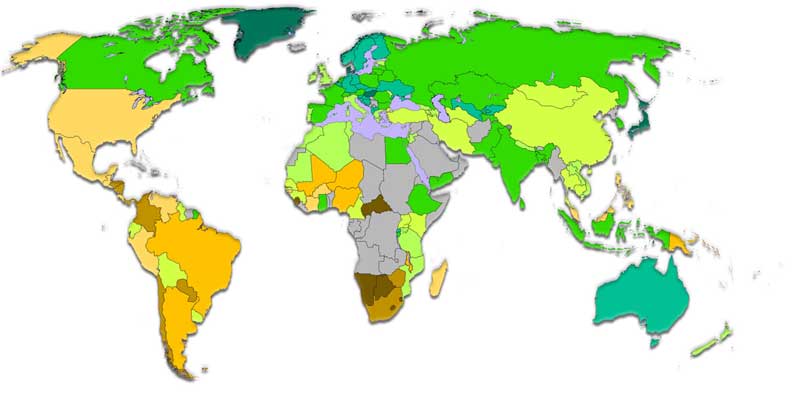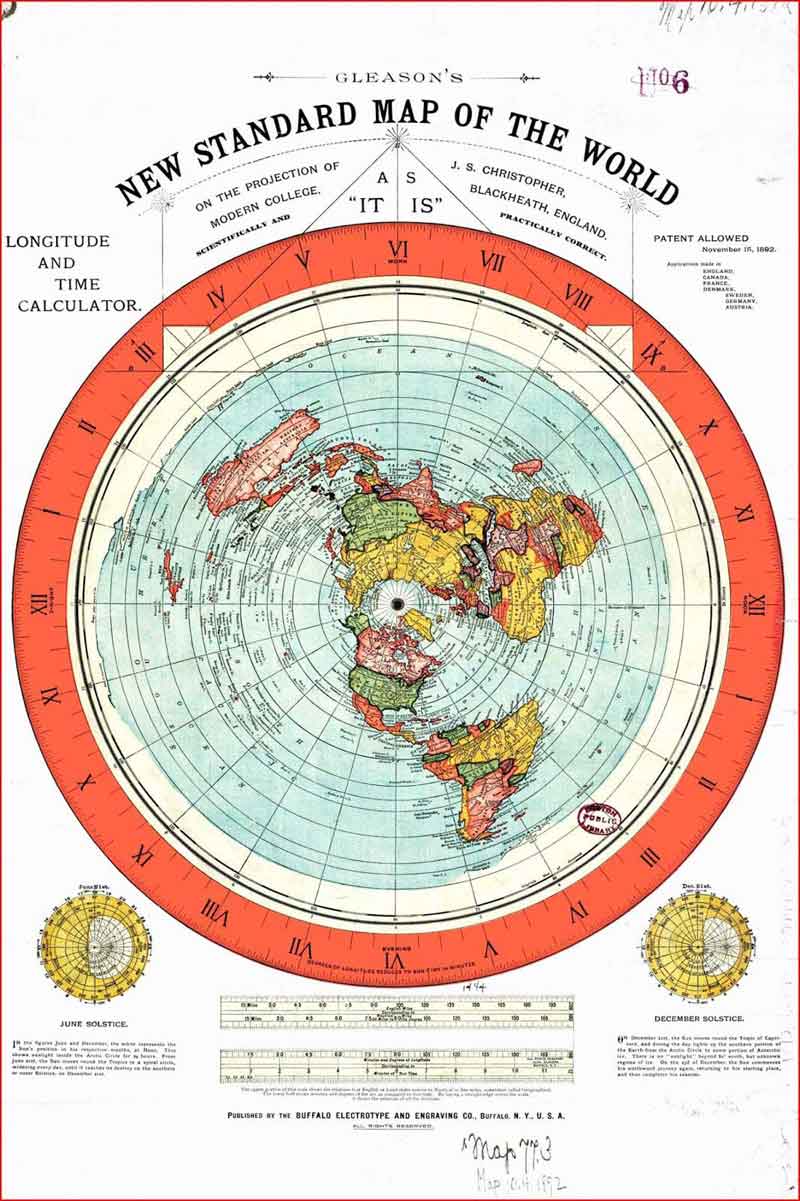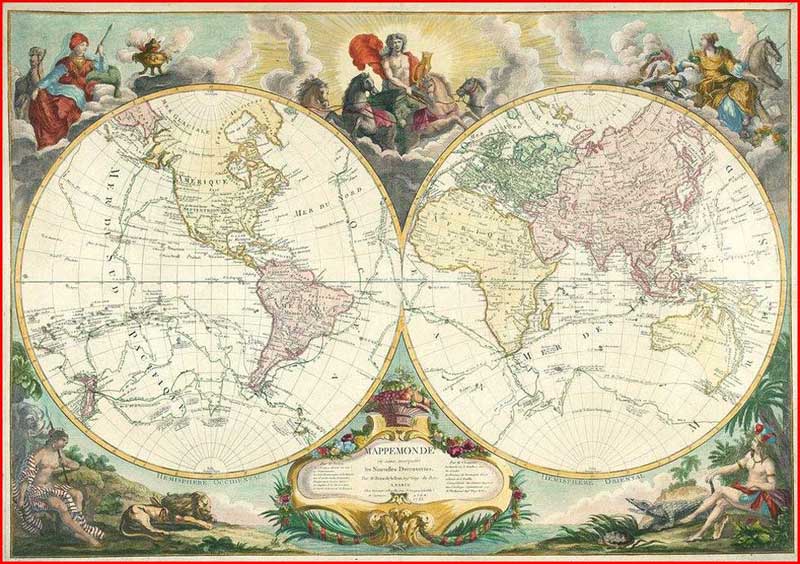Maps of the world allow you to see a clear world map of where countries around the world are located and their locations. You can also find out where the country is by continent.
This high-resolution world map uses various colors with the aim that you can know or distinguish between one country and another even if it is only at a glance.
We upload this latest world map in large size, you can download it on a computer or mobile phone easily so that the text of the name of the country that was previously small with the zoom feature you can see it. Please download the 2018 world map image below, with a size of only 487 KB.
Latest HD World Map

In addition to the map above, we also include a world map in various forms below:




Ancient World maps
In the days of ancient civilizations, it turns out that humans have also known maps. They already have an image of how the shape of the land, seas, mountains, and everything on this earth is shed in ancient map images.
A British researcher and writer have spent 2 years just collecting ancient and antique world maps. In his book, The Golden Atlas: The Greatest Explorations, Quests, and Discoveries on Maps, he describes a world map that is currently rarely known to people in general.
The original version of the ancient world map sold for millions of US dollars or in tens of billions of rupiahs. This price is directly proportional to the rarity of the ancient world map.
Below are 5 kinds of ancient maps that we collected from various sources:






Distribution of Continents in the World
The surface of the earth consists of land and sea. Very large landmasses are called continents, while very large oceans are called oceans. The division of the world’s continents is based on historical conversions. The world map is divided into six continents, namely Africa, America, Antarctica, Asia, Australia, and Europe.
In the first millennium, shipping activities were only centered in Asia, Europe, and Africa. However, out of curiosity, the Europeans began an expedition to explore the two largest oceans, namely: the Pacific Ocean and the Atlantic Ocean.
In the Middle Ages, the Americas were discovered. Why is it called America? The word America is taken from an Italian merchant, explorer, and world mapper who realized America was not part of Asia. The merchant was named Amerigo Vespucci. He exposed the fact that America stretched from north to south much wider than the Europeans had believed at the time. Because of its vast land area, it is called the Americas.
Around the 18th century, an English explorer named James Cook discovered Australia. James Cook developed power there and succeeded in making Australia a British Commonwealth country. Because of its vast land area, this area is called the Australian continent.
In the 19th Century, various expeditions by explorers discovered the Antarctic continent. From various expeditions carried out, concluded that Antarctica does not have a native population. The reason is that the extreme cold climate of Antarctica occurs throughout the year. The average temperature is between -55 to -90 degrees Celsius.
History of World Map Making
Making a world map can be grouped into 4 phases, namely: the early period, the middle period, the glorious period, and the modern period. This is influenced by the development of human thinking power which gave birth to modern science and technology.
1. Early Period
According to the records of world historians, the first world map was made in 2300 BC by the Babylonians. Tools for making maps at that time used tablets from clay. In Ancient Greek Civilization, various sciences developed very rapidly, including cartography.
Cartography/mapmaking is the study and practice of making maps or globes. Maps have traditionally been made using pen and paper, but the advent and spread of computers have revolutionized cartography. Many quality commercial maps are now created with map-making software which is one of the three main types; CAD (computer-generated design), GIS (Geographical Information Systems), and specialized map illustration software. (Source: Wikipedia)
Aris Toteles was the originator of the concept of a spherical earth and later received recognition from philosophers and geographers at the time. In the years 165 – 85 BC in Greece and Rome, the science of cartography reached its peak thanks to the cartographer named Ptolemy, better known as Ptolemy.
2. Medieval Period
In the Middle Ages, religion ruled civilization, therefore in realizing the depiction of a world map, one must also follow a religious perspective. In Jerusalem a famous world map was created in the shape of a T-O, the image is round (O) and inside it is divided into three parts (T), on the top, it shows Asia and the bottom 2 sides are Europe and Africa.
In the 12th century, the Vikings made an expedition to the North Atlantic and they believed in the true shape of the earth. Many hand-drawn maps were created by nations in Arabia and the Mediterranean.
3. Glorious Period
In the 15th century, wooden tools were invented that could be used as map printers. The next century (16), found that copper material was developed as a printing tool and became the basis for making maps until the development of photographic techniques.
Also in this century, Gerardus Mercator created cylindrical projections to depict maps. This is what until now we know as the globe.
4. Modern Period
Starting in the 17th century, map-making technology continued to be developed. Making maps in the modern era is the process of making maps using satellite technology, aerial photos, and direct checks in the field. Of the three that can be done can create an accurate map.
Longitude and Latitude
Of course, no stranger to our ears. Since elementary school, we have been introduced by Mr. / Mrs.’s teacher. Longitude and latitude are imaginary lines used to divide the map of the earth perpendicularly between north to south and east to west.
The originator of longitude and latitude was Erathostenes in the 3rd century BC. But this concept was only introduced in the 2nd century BC by Hipparchus. Entering the 11th century, Al-Biruni suggested that the earth rotates on its axis, this is what underlies modern science regarding the relationship between the calculation of time and longitude. The following is a complete discussion of these two imaginary lines:
1. Longitude
Longitude is an imaginary line that divides the earth from north to south. This line is also known as the meridian line. The function of longitude is as a determinant of time and calendar. 0 degrees longitude is in Greenwich, England which became the initial benchmark for calculating international time (GMT, Greenwich Mean Time).
Longitude is divided into two, namely: east longitude (BT) and west longitude (BB). Both east and west longitudes stretch from 0 to 180 degrees.
2. Latitude
Latitude is an imaginary line that runs from east to west. The function of latitude is to divide the earth into the northern and southern hemispheres. Latitude 0 degrees is also called the equator/line, and in Indonesia, it is called the equator. North latitude (LU) is on the equatorial side and south latitude (LS) is on the south side.
On the world map, there are special latitudes, including 0 degrees, 23½ degrees, 66½ degrees, and 90 degrees.
- 0 degrees is the equator
- 23½ degrees is called the return line which is the boundary line of the sun’s apparent orbit
- 66½ degrees is called the polar circumference and 90 degrees is the polar point.
Latitude is also used as a benchmark for differences in climate on earth, namely:
- 0 – 23½ degree is tropical climate
- 23½ – 66½ degrees is a sub-tropical climate
- 66½ – 90 degrees polar climate.
The tropical climate is divided into 2 seasons, namely summer and rainy season. The sub-tropical region has 4 seasons, namely summer, autumn, winter, and spring. While the polar climates have only winter, one day and one night during the year. Change of day and night occurs every 6 months.
